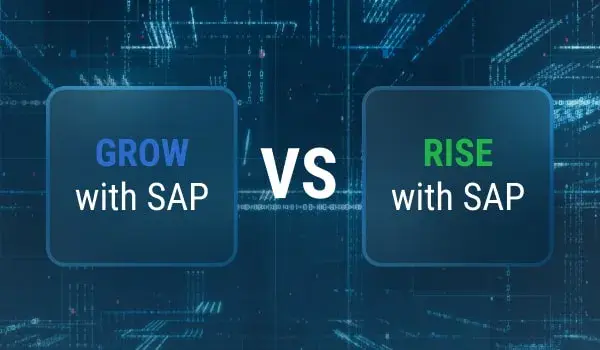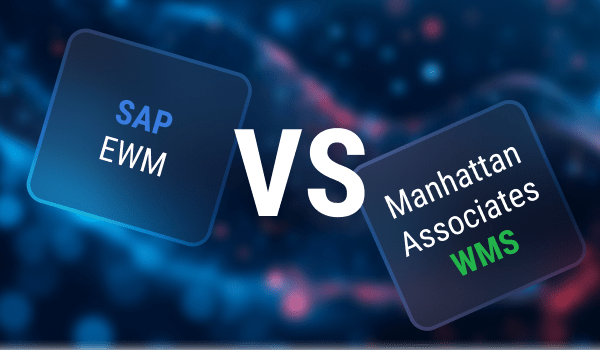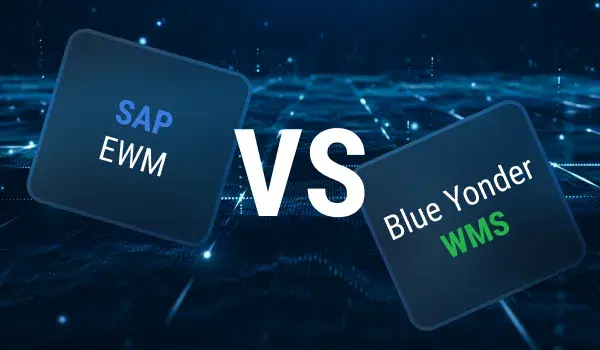Check the key differences between SAP EWM embedded and decentralized deployment models and learn how to choose the best option for your business.
SAP Extended Warehouse Management (EWM) offers two primary deployment models: embedded and decentralized. Choosing the appropriate model is crucial for optimizing warehouse operations, as each offers distinct advantages regarding integration, scalability, and performance. The decision should align with the organization's size, operational complexity, and long-term strategic goals.
In this guide, we’ll cover the core aspects of the difference between decentralized and embedded SAP EWM, establish the pros and cons of each approach, and help you choose the best option for your business.
Introduction to SAP EWM
SAP Extended Warehouse Management (SAP EWM) is an advanced software solution developed by SAP to manage complex warehouse and logistics operations efficiently. It is part of SAP’s Supply Chain Management (SCM) suite and is designed to support the entire warehouse process — from inbound goods receipt to outbound delivery, and everything in between. SAP EWM offers enhanced capabilities and integration with SAP S/4HANA. It replaces SAP WM, which approaches its end-of-life in December 2025 (extended support for SAP ERP 6.0 available till December 2027).
Core functions of SAP EWM
SAP EWM offers a comprehensive set of tools and functionalities that help organizations successfully manage warehousing operations and streamline processes, ensuring transparency and data synchronization within the whole system:
- Inbound and outbound processing: Manages goods receipt, storage, picking, packing, and shipping.
- Inventory management: Tracks inventory at a granular level (bin-specific).
- Warehouse order creation: Automates creation of optimized work assignments.
- Slotting and rearrangement: Optimizes product placement for faster picking.
- Labor management: Tracks productivity and performance metrics for warehouse staff.
- Yard management: Monitors and controls vehicle movement outside the warehouse.
- Resource management: Handles the efficient use of forklifts, conveyors, and other equipment.
- Radio frequency (RF) integration: Supports mobile data entry for real-time updates.
SAP EWM key features and benefits
SAP EWM offers advantages that allow for scalability and prompt, data-driven decision-making to stay ahead of the competition and quickly adjust to changing market conditions.
For example, advanced automation features make it possible to integrate with robotics, conveyor belts, and automated storage systems that help provide predictive maintenance for machines and prevent stockouts and overproduction. This reduces manual workloads, resulting in faster production timelines. Besides, real-time data synchronization enables instant visibility into inventory and operations, streamlining decision-making and process coordination between departments.
The high level of customization helps clients from different industries (e.g., retail, automotive, pharmaceuticals) tailor SAP EWM based on their specific needs. Integration with the SAP ecosystem ensures seamless connection with SAP S/4HANA, SAP TM, SAP SuccessFactors, and/or other SAP solutions you use in your company, creating a single source of reliable data across the organization.
What is Embedded SAP EWM?
Embedded SAP EWM refers to the deployment of the EWM system directly within the SAP S/4HANA suite. It shares the same database and technical platform as the core ERP, eliminating the need for a separate, standalone warehouse management system.
This model is natively integrated with other SAP S/4HANA modules such as Materials Management (MM), Sales and Distribution (SD), and Production Planning (PP), allowing seamless data flow across business functions.

Embedded SAP EWM comes in two editions, basic and advanced. Basic embedded SAP EWM is included with the standard SAP S/4HANA license, offering essential warehouse management functionalities suitable for simpler operations. Advanced embedded SAP EWM requires an additional license, but offers more advanced features like labor management, slotting, and yard management.
Key characteristics of embedded SAP EWM
- Tight integration: Embedded SAP EWM is fully embedded in the S/4HANA environment, so no middleware or additional interfaces are required.
- Simplified architecture: Embedded EWM shares the same HANA database as the ERP (S/4HANA), which reduces landscape complexity and simplifies navigation.
- Real-time data access: The solution allows for inventory and warehouse transaction updates in real-time across all modules, ensuring data integrity.
- Lower total cost of ownership (TCO): The absence of expensive middleware reduces the number of systems to manage and maintain, which makes overall system maintenance less costly.
What is Decentralized SAP EWM?
Decentralized SAP EWM is a deployment model in which SAP EWM runs as a standalone application, separate from the core ERP system (such as SAP S/4HANA or SAP ECC). It operates on its own instance, often on a separate server and database, and communicates with the ERP via standardized integration methods:
-
IDocs: for asynchronous data exchange (e.g., deliveries, stock transfers)
-
qRFC (Queued Remote Function Calls): for reliable, ordered message processing
-
Web Services & APIs: for modern, flexible integrations
_11zon.webp?width=1664&height=948&name=832x668_Picture_2%20(1)_11zon.webp)
Decentralized SAP EWM offers greater flexibility, independence, and scalability, making it ideal for complex, high-volume warehouse environments or businesses that operate multiple warehouse locations across geographies.
Key characteristics of decentralized SAP EWM
- Standalone system: SAP EWM is deployed separately from SAP S/4HANA, with its own application server and database.
- Independent processing: SAP EWM can operate autonomously from the ERP system, which helps maintain continuity, even if the ERP is down.
- Multi-ERP integration: Decentralized SAP EWM can connect to many different ERP systems, including non-SAP solutions.
- High customizability: The decentralized version offers more flexibility in developing and extending warehouse processes.
- Greater system load handling: Isolated infrastructure allows SAP EWM to manage high transaction volumes.
Key Differences Between Embedded and Decentralized SAP EWM
Embedded and Decentralized SAP EWM differ in terms of functionality and features. Let’s summarize the key aspects.
Embedded SAP EWM seamlessly integrates with SAP S/4HANA and does not require any additional connectors. Decentralized SAP needs additional means of communication with the ERP system, due to hosting on independent servers.
Decentralized SAP EWM is more independent and allows for more powerful customization and flexibility, making it more suitable for bigger companies that manage more complex warehouse operations. Embedded SAP EWM’s customization is a little more limited by the features of the ERP system (SAP S/4HANA). Still, this helps companies achieve lower TCO due to simplified architecture and reduced infrastructure costs.
Summing it all up, decentralized SAP EWM is an independent solution that can be run without greater dependency on the ERP resources, while embedded EWM is literally a part of the ERP.
The table below should help you better understand the key differences between these two deployment approaches to SAP EWM.
| Aspect | Embedded SAP EWM | Decentralized SAP EWM |
| Integration | Seamless within S/4HANA | Requires interfaces (RFC, IDocs) |
| Architecture | Shared database with the ERP | Separate system and database |
| Scalability | Suitable for moderate complexity | Ideal for high-volume, complex operations |
| Customization | Limited compared to decentralized | High flexibility and customization |
| Resilience | Dependent on the ERP system availability | Operates independently of the ERP system |
| Cost | Lower TCO with basic functionalities | Higher TCO due to separate infrastructure |
SAP EWM Embedded and Decentralized Pros and Cons
Embedded and decentralized SAP EWM both have their strengths and weaknesses, so businesses should rely on their core objectives when choosing the most suitable approach.
The pros and cons of the embedded SAP EWM are:
Embedded SAP EWM offers a simplified system landscape due to being seamlessly integrated with SAP S/4HANA.
The embedded nature means lower implementation and maintenance costs, as you literally maintain EWM as a part of your ERP system.
Embedded EWM ensures real-time data access within SAP S/4HANA, providing you with up-to-date stats any time you need them.
Embedded SAP EWM has limited scalability for complex operations, as it does not work as a standalone solution.
The embedded version may face potential performance issues under high load.
Predefined SAP S/4HANA structures result in less flexibility for customizing EWM.
In the case of the decentralized SAP EWM, the situation is completely backwards:
Decentralized SAP EWM offers high scalability, easily handling performance under heavy loads without slowing down the ERP.
Being a standalone option, decentralized EWM has greater flexibility and customization options.
Decentralized SAP EWM operates independently of the ERP system, thus it is possible to connect EWM to a greater variety of ERPs, including non-SAP offerings.
Decentralized EWM is located on a separate server, which implies higher implementation and maintenance costs.
The decentralized version of EWM has increased complexity due to system interfaces, which may require additional resources for seamless data connection and maintenance.
Decentralized SAP EWM requires more technical resources and expertise at every stage of implementation and maintenance.
When to Choose Embedded SAP EWM and Decentralized SAP EWM
The embedded and decentralized models of SAP EWM cater to different business objectives and either may help your enterprise streamline warehousing processes if chosen correctly.
Choose embedded SAP EWM
The embedded SAP EWM will be the best option if:
- Your warehousing operations are moderately complex, and you don’t have many separate warehouses to be managed under different regulations and requirements.
- You have already moved your processes to SAP S/4HANA and need real-time data integrity within a single system.
- You opt for a cost-effective solution with simplified maintenance, which reduces the burden on IT departments and provides an easier learning curve.
Choose decentralized SAP EWM
As for the decentralized SAP EWM, you can choose this approach if your business needs align with the following:
- Your company manages large-scale, complex warehouse operations within different ecosystems and locations.
- Your business processes are beyond standardized and require high customization and flexibility to set everything up smoothly and effectively.
- You haven’t moved to SAP S/4HANA, you’ve partially transitioned, you use several ERPs, or you operate within a non-SAP ERP solution, and want your warehousing systems to be resilient and independent from ERP shifts or possible lags.
LeverX Helps With Any SAP EWM Services
As a trusted SAP partner for more than 20 years, LeverX is here to help you, regardless of what implementation approach you choose for your SAP EWM solution. Our experts will closely collaborate with your team to offer you a detailed plan with key steps of your EWM integration, implementation, maintenance, support, and training.
With our help, you will maximize the benefits of SAP EWM and eliminate endless manual processes, siloed outdated systems, costly stockouts, vague processes, and costly warehousing mistakes that may prevent you from being competitive on the market. Contact LeverX today for a detailed consultation.
Conclusion
Selecting between embedded and decentralized SAP EWM depends on your organization's specific needs, including warehouse complexity, scalability requirements, and integration preferences. So, when making your choice, consider business objectives, current operations, and future growth plans. Doing so will guide you to the most suitable deployment model to ensure efficient and resilient warehouse management.
How useful was this article?
Thanks for your feedback!



.webp)